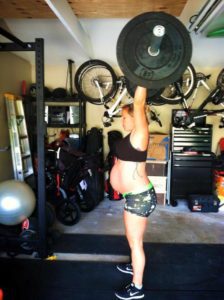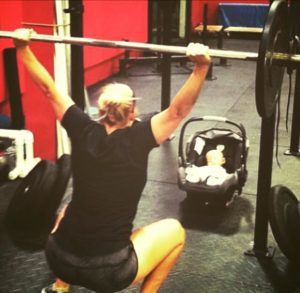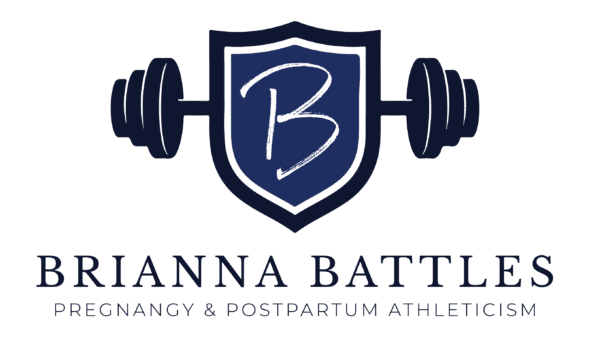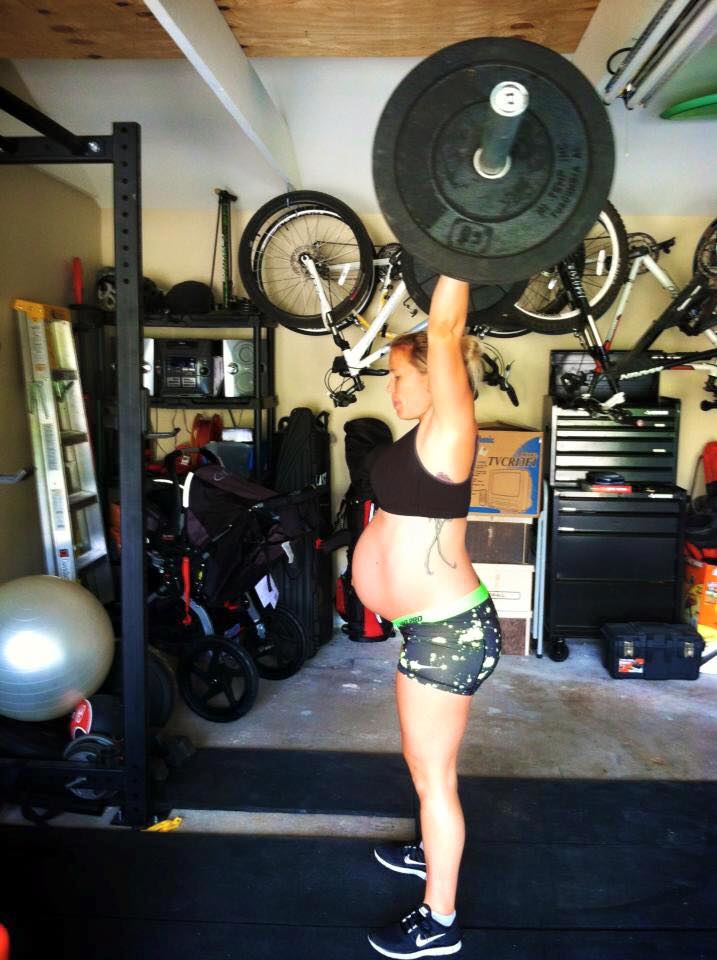
A couple months ago, this (also pictured) went viral. Like, OMG, people get it. They wanted to give me virtual high five, thank me, ask questions, get coaching and guidance, maybe get a little defensive, but whatever…this made an impact. The message I’ve been screaming, the topic I had become SO passionate about, seemed to finally resonate and inspire conversation, bringing to light a whole different side to the conversation.
But, here’s the rest of the story…
When Cade was 6 months old I KNEW something wasn’t right within my body. It wasn’t my stretched skin or my size…it was how I felt and honestly, how my belly button looked. As if my delivery and motherhood hadn’t been hard enough, I was now trying to troubleshoot my body.
Nothing hurt. Nothing sent obvious signals that there was anything thaaat wrong with me. My OB said I was doing great and had nothing to be concerned with. I, of course was on Dr. Google a lot and found information-conflicting, overwhelming, complicated, un-relatable, information. Nothing resonated. I shared what I found, what I was trying and basically learned what I shouldn’t be doing for Diastasis Recti. So, I stopped crunching and planking and everything that Dr. Google tells you. I did the exercises you find online and hoped that this would do something.
A Chiropractor told me to keep up the good work with my training and just put some tape on it! I did that, for over a year. Guess what? Tape doesn’t do shit when you’re not fixing the actual problem.
The various birth professionals I saw and was collaborating with through pregnancy didn’t even know how to check me. I introduced this condition to them. Whaaaat?!
A Physical Therapist told me to manually push my abs together 100x a day.
Dr. Google and the barricade of mommy fitness know-it-all’s, said to bind and squeeeeze those abs back together. But guess what? Adding even MORE pressure to a dysfunctional pressure system…can you guess? It doesn’t solve the problem, in fact, it can create an even greater problem, especially when not used appropriately and fitted by a professional.
A Plastic Surgeon told me I should just get a tummy tuck (I was probably 24% body fat).
A General Surgeon said I had a hernia and to repair it right away. So I had surgery before truly repairing my existing Diastasis. I thought maybe it was just this hernia all a long. A mesh implant was put in, 6 weeks of recovery and another setback to feeling like my body was right.
Truly, no one every mentioned how I would need to modify my form/alignment to heal properly. No one mentioned connecting my pelvic floor to my breathing, or change up intensity and movement patterns. No coach or professional in the strength and conditioning or high intensity interval training community said to take my freakin’ weight belt off, to stop holding my breath with lifting and to stop any high impact activity. I should have known, but I didn’t. This was never part of my education, and I suppose I couldn’t expect many others to know either. Just 4 years ago, there weren’t many people training like this, nevertheless through pregnancy and after having a baby. This “training population” is still new and what’s glorified in the media, isn’t necessarily the right message for pregnant and postpartum athleticism.

A lot of the “high intensity interval training style” and lifting movements I had been doing, and the way I was doing them, wasn’t conducive to what it takes to rehab Diastais- at least not the way I was doing them. My form was great by “normal, athletic” standards, but when you’re pregnant and postpartum, what’s considered “normal,” changes, in ALL ways, lifting and movement patterns included.
I was told everything from “you’re cleared, to listen to your body, to you’ll bounce back great, to you look great, to just start slow.” I did all of that in all the ways I knew. That’s simply not good enough information for the pregnant and postpartum athlete. It’s crazy to me that the circle I was in was so naive to this demographic…myself included. I had just always believed that my body was made for this (pregnancy, delivery, recovery) so I had nothing to really worry about. I thought I was fit, young and healthy and therefore would somehow avoid any “issues.” Arrogant and stupid.
You know what no one mentioned? That I would need to fix my brain to fix my Diastasis Recti.
That is, until I made the investment in reaching out to one of the greatest sports medicine/women’s health Physical Therapists in the world, Julie Wiebe, PT. She was out of my league and I was so intrigued by her work. I had been reading through Julie’s content for a while, and after meeting Jen from Mama Lion Strong, and learning about her experience with Julie, I followed through with contacting Julie. Long story short, this lead to rehab, mentoring and now, collaboration. It was the best investment in my brain, continuing education and body that I have ever made.
I had to learn a new strategy. As a coach, someone who enjoys lifting weights for exercise, an occasional high intensity interval training workout and mom life responsibilities, this meant I needed to pay attention to details that were NEVER a priority to me prior to having Cade.
Alignment- pelvis and rib cage positioning in lifting and in daily life.
Piston Breathing– coordinating the pelvic floor and diaphragm. This was totally reversed for me. I held my breath (unknowingly) for everything- from a 200lb squat to lifting my 20lb baby. And no one EVER talked to me about my damn pelvic floor.
And who’s teaching strategy? To name a select few…Julie Wiebe in Los Angeles. Antony Lo in Australia, Beth Learn in Oregon, Jesse Mundell in Canada, Jen Campbell in Canada and Lorraine Scapens in New Zealand and me, of course. 😉 They’re the ones sending the right message about what it means to train well during pregnancy and postpartum, regardless of what kind of athlete or occasional exerciser you are. This expertise is unique. As I mentioned in this blog, the problem with mommy bootcamps, even college educated, highly certified (myself included) coaches and trainers are NOT aware of training and recovery implications for this population.
Healing Diastasis Recti isn’t as simple as do these 6 exercises and a few kegals, 3x/week for a couple moths. I wish it was that simple. Not even my 6 week program is enough- it’s a start, but it’s ownership of implementing exercises, daily habits and keeping “athlete brain” in check. I wrote a lot about essential strategies, implementation and guidelines here and here. If you’re a coach, athlete or anyone struggling to heal DR, please read those two blog posts.
Many of the online programs and discussions will give you exercises to do, NOT strategies. There is no quick fix for diastasis recti or any other core and pelvic floor dysfunction.
Your exercises will not work unless you have a strategy (alignment, connecting the dynamic relationship between the core and pelvic floor and dialed in movement patterns) that supports core function. For example, a common Diastasis exercise is a heel slide, or bird dog. I see these exercises in nearly all DR programs. For ME, my core- fascia and closure was made WORSE when doing these “simple” exercises. It wouldn’t respond! Yet, when given a greater stimulus- a 135lb deadlift (again, 2 years postpartum here, people) and used the piston breathing- my fascia fired and abs came together. Is this right for everyone? NO. But, it proves the point that there’s no one size fits all approach to healing this. It’s essential to work with a qualified coach and Pelvic Floor PT. I had a very complicated Diastasis- one side pulled further over, the mesh from the hernia repair, a screwed up hip flexor, a weird rib, severe scar tissue around my c-section and even my left shoulder, were variables that impacted closure. It took so much troubleshooting and patience, but Julie’s brain is incredible and together we kept working to where we were both at peace with my rehab. I never had to give up my training- I just adapted and added some things (form, breath, new movements), but at no point did I have to stop my training completely or take on an exercise routine that was “boring or lame.”
Being a tough case myself has made coaching my athletes SO MUCH EASIER!
I KNOW that some of what I did during pregnancy and what I did those first 6 months postpartum made this dysfunction worse and that sucks to admit. I really never felt like I was doing anything wrong or harmful, until it was too late…until I knew better. Everyone talks about the baby’s safety, but what about the mother’s body and recovery? Why aren’t people concerned with that, too? Being strong, young and fit doesn’t save you if you aren’t allowing your body to change and rehab appropriately. I started too much, too soon postpartum, which can be so detrimental, even for the fittest of women. When I met Julie, nearly 2 years postpartum and so depressed about my body, I was separated by 7cm above, below and at my umbilicus. I’m now at a 1.5/2ish right at the belly button, mostly where the mesh is and my fasica is dense and responds really well! I can lift and not be scared that I’m making it worse. It feels really good to be HEALED and confident in my body again.

If you’ve followed me long enough, you know that I have made a lot of changes to my coaching, methodologies, cueing, collaborations and overall philosophy, especially when coaching the pregnant and postpartum population. I am running my own business in a way that resonates with my foundation of education and belief, as well as the continuing professional development I’ve done to learn everything I can about this subject matter. This is a unique population that deserves compassion and education.
This whole journey has been a tremendous amount of change, ownership and vulnerability, but it’s paved a path I could have never imagined, in the best possible way.
If you have Diastasis Recti or think you do, OR if this is something you’ve never even heard of, please go to a Pelvic Floor Physical Therapist– don’t waste your time elsewhere like I did. Postpartum pain and dysfunction (Diastasis Recti, prolapse, ANY incontinence) is incredibly common and knowingly or unknowingly ignored- even among the fittest of people. There are answers and I’m happy to help guide you because no woman should have to feel disappointed and confused about their body after having a baby.


Thank you for an absolutely amazing article on this topic! Love everything about it!!!
I’ve had to do all the DR research myself too… doctors in the UK never mention it. I defo owly had it after number 2 (also a Cade!! Weird) and now again after number 3… but getting there slowly!!
Enjoyed reading… Thanks for sharing!
So glad you are getting the word out to young women. Pelvic floor issues, hernias, rectoceles, etc, sometimes don’t surface for years. The mother’s body, especially, is at risk.
Great article! Add me to the list please Jasmine Craner, Columbus Ohio. I’ve been working with people (it’s not just a problem with postpartum moms) on pelvic floor activation and breathing/firing pattern coordination for years and it can be a very difficult thing for people to achieve depending on how dysfunctional their is. You’re absolutely right, there aren’t many people who are teaching the things you discussed above.
Thanks for sharing your experience so more people can become aware of where and how to get help!
Also, you mentioned “your program” do you have a home program for people? It might be something I’d like to look into getting my patients set up with if that’s the case. I’d love to chat more 🙂
Also, I’m excited to look through what some of these other professionals you mentioned are teaching. There’s always more to learn and share. Again, great article
Yes, I do offer remote coaching for pregnancy and for the postpartum period. Thanks for reaching out and feel free to email me if you’d like to collaborate- briannabattles@gmail.com
Pingback: What I Would Do Differently as a Pregnant and Postpartum Athlete – Everyday Battles
I just came across your article and I’m sad but hopeful. I was just diagnosed with a hernia and will have to have surgery soon to fix it. I’ve had four babies and my youngest is 10 months old. I have bad diastasis recti. I’m not a crossfitter or lifter but I take Zumba classes a couple times a week. I am just getting back into a good exercise groove and it’s coming to a screeching hault because of the hernia. Does a hernia result from DR? It makes me mad that I have one and I’m worried that having surgery will spiral my autoimmune issues downward. Thanks for posting your article and I look forward to
Reading more of your posts
Send me an email..briannabattles@gmail.com
Awesome and very informative article! So very true about getting conflicting information – whether from your OB or from Dr. Google. You can find information that may be useful, but as you rightly said…it is not an easy fix and is best to find a pelvic floor PT. I have been doing the Postpartum Strong program and it has done wonders for not only my abs but for my pelvic floor strength.
God bless you for this. 4mths Pp